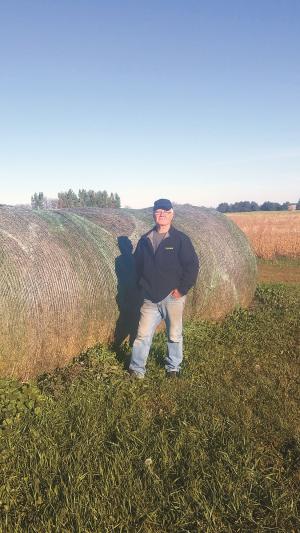2017 - Volume #41, Issue #6, Page #18
[ Sample Stories From This Issue | List of All Stories In This Issue | Print this story
| Read this issue]
Organic Hay Pays Off For Minnesota Farmer
 |
“Canada thistle is the most challenging weed for me farming organically,” says Fernholz. “A good solid stand of pure alfalfa left in place for 3 years is the best practice I’ve found to keep Canada thistle at an acceptable level.”
Fernholz seeds his alfalfa at about 15 lbs. per acre with a cover crop of oats, wheat, barley or dry field peas. He harvests the cover at maturity.
“If you plant as early as possible, the alfalfa sprouts, but then lays quiet,” says Fernholz. “When you take the cover crop off, the alfalfa blossoms through.”
With later frosts, Fernholz thinks he could take a cutting of alfalfa the first year. Normally he clips it with a rotary mower twice. The first clipping is about a month after harvesting the cover crop. The second is about a month later, especially if he gets weeds coming through with the regrowth.
“Chopping it off provides more cover and biomass to the field,” says Fernholz.
Fernholz hasn’t had many serious insect or disease pests in his fields since alfalfa weevils struck 5 years ago.
“They would come in toward first bud stage, and when you cut, the larvae would form under the windrows and devastate the stubble,” recalls Fernholz. “That allowed grasses like foxtail to come through.”
Fernholz applies 1,500 to 2,000 gal. of liquid hog manure to his alfalfa each fall for needed phosphorus and potassium. When it is time to terminate the alfalfa, he does it with a 2-pass system. He rips and chisels the ground in the fall and follows with a second pass with a field cultivator in the spring. Once terminated, he follows with a year of corn and one of soybeans before planting the soil again to alfalfa.
Fernholz says organic hay production has been an important part of his operation and not just because of the premium paid. In fact, for the first 20 years he raised it, he sold it on the conventional hay market.
“If you have an organic dairyman within 100 miles, that is usually the best market,” says Fernholz. “However, even without a premium, alfalfa is terrific for building soil structure. I can see the benefits 4, 5, 6 years later.”
Contact: FARM SHOW Followup, Carmen Fernholz, 2484 Hwy. 40, Madison, Minn. 56256 (ph 320 212-3008; fernholz001@gmail.com).

Click here to download page story appeared in.

Click here to read entire issue
To read the rest of this story, download this issue below or click here to register with your account number.




